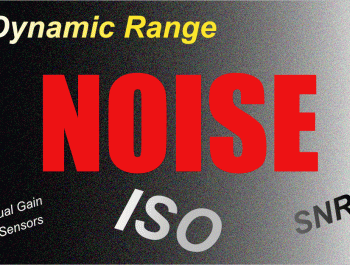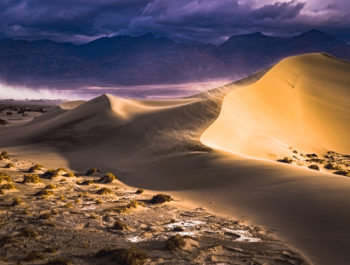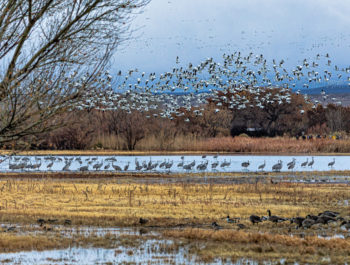The Optimum Digital Exposure
Concepts from my book of the same name…
The Optimum Digital Exposure – “Introducing the OneZoneTM Digital Exposure Method”
For too long we have been accepting the “digital look” of our photographs. The compression of tones, especially in the dark areas, seems intrinsic to digital photography, but in reality, it is the result of “non-optimum” exposure. With optimum exposure, you do not have to compromise the film-like appearance with digital photography.
It has been more than 15 years since Michael Reichmann wrote about the concept of ETTR (Exposure To The Right) 1 Michael Reichmann. Originally the primary benefit was to separate the signal from the noise of the sensor, especially in earlier digital cameras. With improvements in cameras/sensors technology and digital processing software, the signal-to-noise ratio has improved greatly. However, there are additional benefits when Exposing To The Right – including more tonal data; more sharpness; less processing artifacts. Though the practice of ETTR has generated much discussion and reworking, photographers still labor to “optimize” their digital raw exposure. What follows is my experience at capturing the optimum digital exposure.
“Optimum exposure for maximum data.”
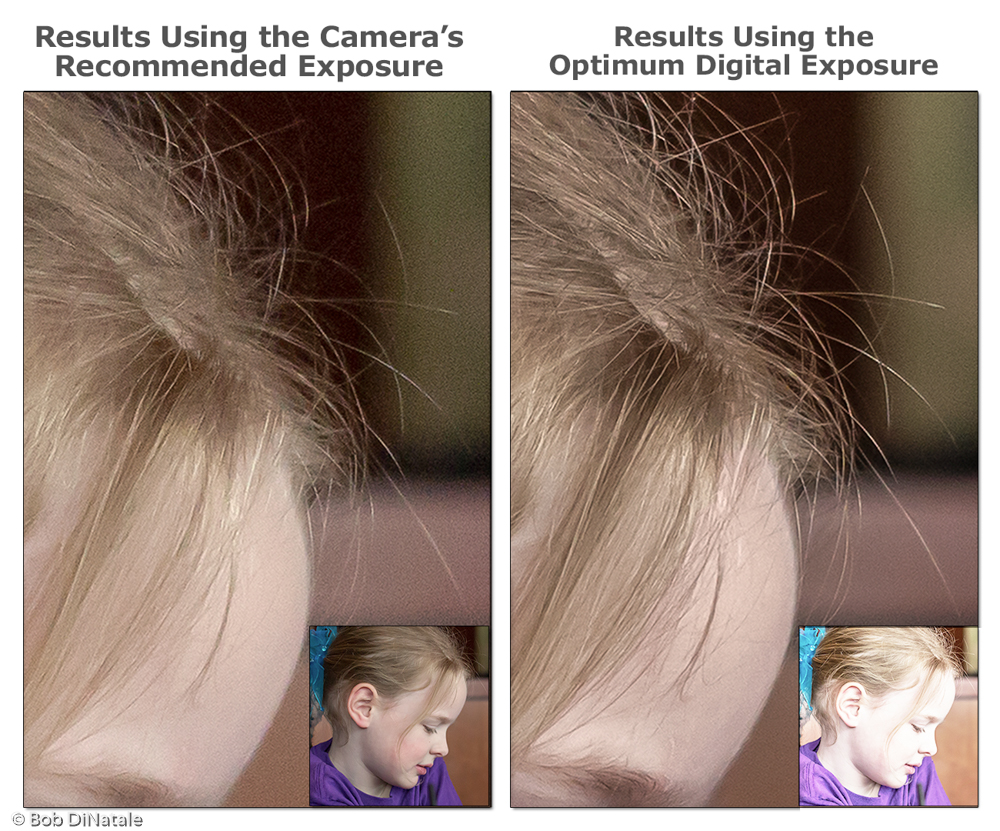
(Final Exposure processed in Adobe Camera Raw). Photo by Paul Casco
Requirement of ETTR – More Exposure
Exposure To The Right requires more exposure than recommended by our camera’s meter reading – (i.e. a plus Exposure Value or +EV). To do this we need to either open our lens or, even more disconcerting, use slower shutter speeds. These slower shutter speeds could cause camera shake or subject movement. To offset this need for more exposure we can increase our ISO to maintain the desired shutter speed. Again, traditionally one would normally be concerned about the increased noise with higher ISO’s. However, remember that the digital noise is mitigated by using ETTR.
The composite below compares noise at higher ISOs. It shows 3 exposures:
- Section “A” & “B” use the camera’s “metered” exposure at two different ISOs (200 & 800). As expected, we can see the increase in noise using the higher ISO – Section “B”.
- Section “C” on the right is also at 800 ISO but shot at an Exposure Value of +2 then, adjusted in raw software to match the brightness of Section “A” & “B”.
- Compare the noise from the camera’s “metered” exposure at 200 ISO (Section A) with (Section C) which was exposed at EV+2 then adjusted in the software to match the brightness of (Section A).
- Notice the noise from (Section C), the EV+2 exposure at 800 ISO, is the same or better than (Section A) the metered exposure at 200 ISO!
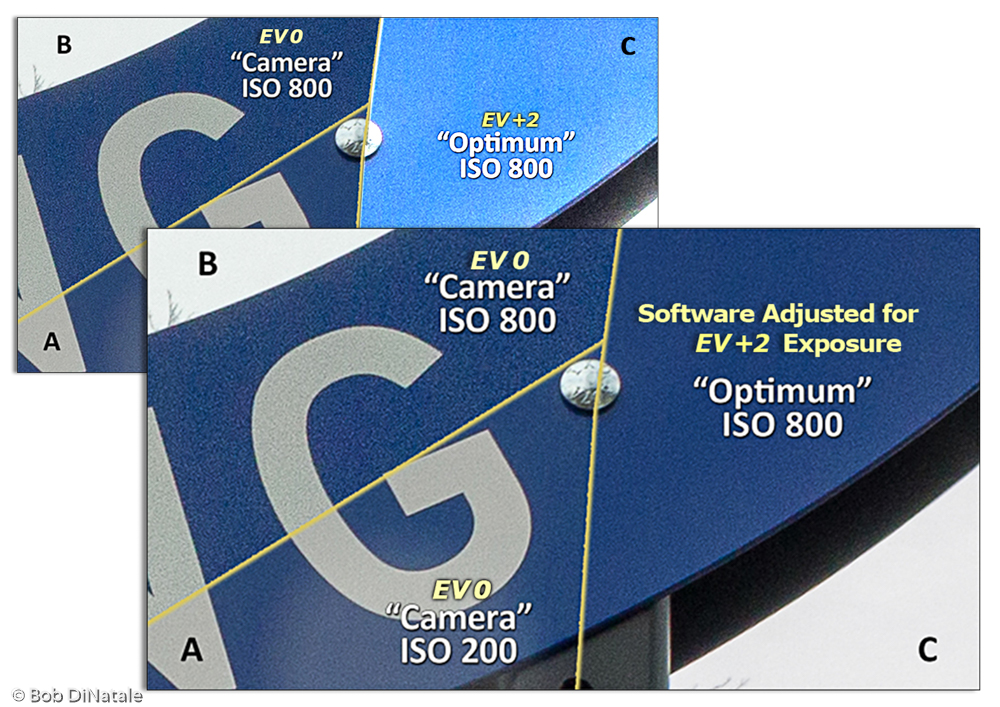
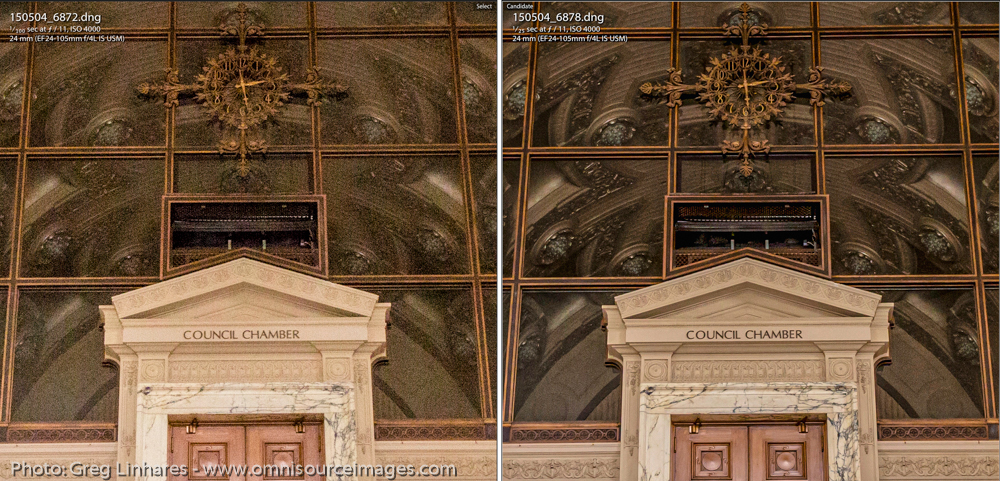
Digital Exposure Facts to Ponder…
- This chart shows increasing exposure 4 stops above mid-tone in 1 stop increments. In an “Optimum” exposure:
- the top 10% of your capture (from 90-99% software brightness) contains 75% of the data!
- the top 3% contains 50% of your captured data!
2 George Jardine “What I found was how dramatic the tonal compression truly is…” Revisiting the Zone System”
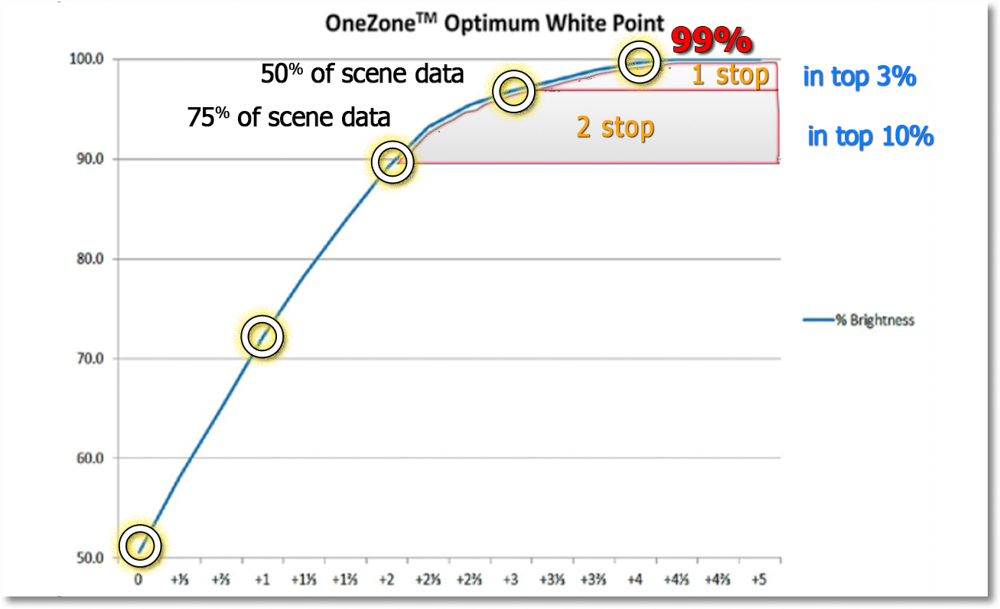
-
- If the brightest part of your scene has a 90% brightness in your software:
- …Your scene is underexposed by two stops!
- …You captured only 25% of the scene’s data!
Ponder – Ponder – Ponder
- Add to that, the little known fact, only about 10% of our digital image is capture by the camera’s sensor – the rest is created by our processing software! 3 Mark Dubovoy – “It is a well known fact that the electronics and the software in a camera play a crucial role in image quality …the sensor is only 10% of the equation and the rest of the electronics and the software represents 90% of the ultimate result…”

“Optimum Exposure is more than important… It Is Critical!”
Different Types of Exposure
When we photographers talk exposure, we are usually talking about the “final processed exposure” – the one we would show the viewer.
“The ‘Camera exposure’ and the ‘Final exposure’ are seldom the same.”
The idea that the camera’s “metered” exposure is not the final exposure is not a new concept. With both black and white and color negative films, when we tripped the camera’s shutter, it was obviously not the final exposure. It was just the first step between the negative film and the negative printing paper that produced the positive print. I want you to think of digital exposure in the same way –
“The camera exposure is just the first step toward the ‘final processed’ exposure.”
Three Types of Exposure:
The inserts show 3 types of exposure choices the photographer has when making a digital capture. Here, we use of two classic photo examples: a black cat in a coal bin and a white rabbit in a snow.
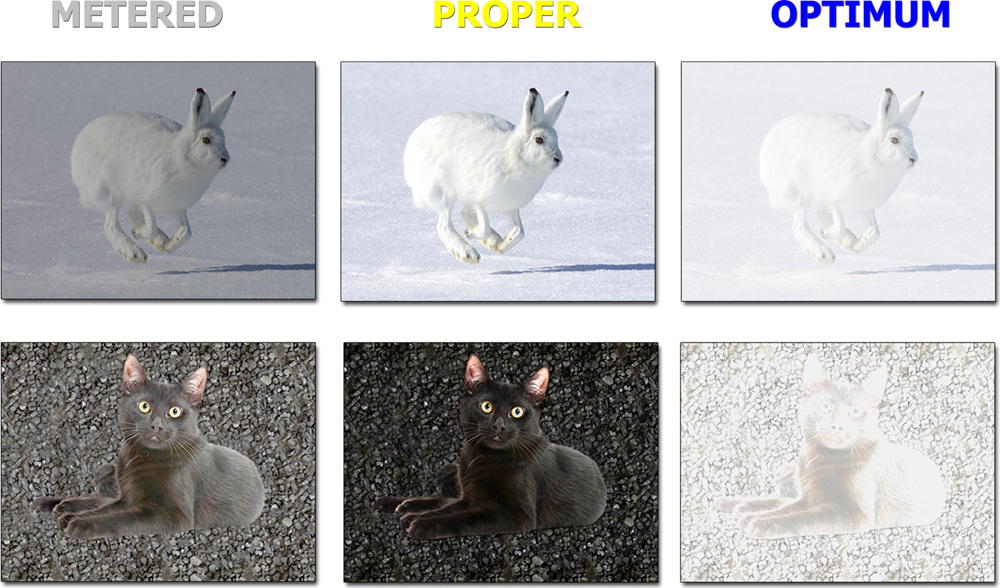
- ➢The Metered exposure places both our white rabbit and black cat into mid-tone brightness – the wrong exposure!
- ➢The Proper exposure would be to adjust the metered exposure: “more-exposure” for the white rabbit; “less-expose” for the black cat. This would place each exposure where the viewer would expect.
- ➢The Optimum exposure places both the white rabbit and the black cat to bright white! The white rabbit is even brighter than its “Proper” exposure. And, in the case of the black cat, the “optimum” exposure places the black cat to a surprising bright white… as bright as our optimum white rabbit exposure.
“The ‘Optimum’ exposure of the black cat and the white rabbit are similar!”
Here Are a Handful of Digital Exposure Axioms:
- The “METERED” exposure and the “OPTIMUM” exposure… Can Never The Same!”
- The “METERED” exposure and the “PROPER” exposure are… Only the Same When Metering A Gray Card.”
- The “OPTIMUM” exposure… Produces Maximum Detail in the Shadows.”
- There is… only one “OPTIMUM Exposure” for any given scene.
<< The best digital exposure is ‘Not Metered’, ‘Not Proper’… BUT ‘Optimum’ ! >>
Note: When viewed before processing, this “optimum digital exposure” will certainly not seem to be the “Proper” exposure. The “Optimum – Digital Negative” cannot be judged BEFORE it is developed by Raw processing software!

“A good digital exposure looks as if it has been dipped in skim milk!”
Defining “The Optimum Digital Exposure [TODE]
“The OPTIMUM Digital Exposure” is the exposure that will place the brightest part of the scene at 99% brightness in your software… the Optimum White Point [OWP].

How do we produce this 99% OWP for an image? We know if we use our metered exposure, the black cat will be mid-tone brightness. However, if we spot-meter the brightest part of the scene – in the case of the black cat, the yellow green of his eye then, “place” that exposure at 99% brightness on the software’s histogram… we would obtain the optimum exposure for that scene.
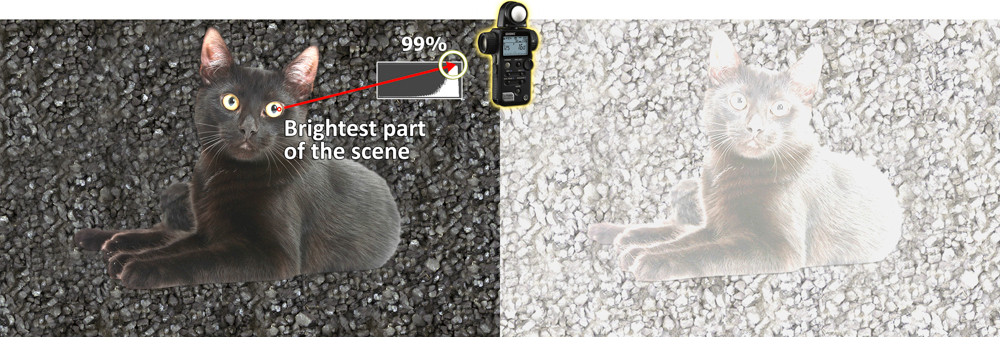
Similarly, if we meter the brightest part of the white rabbit – his hind leg, then “place” that exposure at 99% brightness on the software’s histogram… we would obtain the optimum exposure for that scene.

“The best digital exposure is ‘Not Metered’, ‘Not Proper’… BUT ‘Optimum’ “
Obtaining the Optimum Exposure – Introducing the OneZoneTM Digital Exposure Methods
I have developed two OneZoneTM methods* for capture an Optimum digital exposure:
- Method #1 uses a spot meter (preferably hand-held) where photographic situations allow ample shooting time.
- Method #2 uses the in-camera multizone meter for shooting situations with little setup time. [Less precise]
Both methods are described in detail in the book’s Chapter 2 “OneZone Procedural Methods”
Method #1 – Using a Spot Meter (overview)
To use Method #1 you need to determine and exposure bias for your equipment. Your exposure bias is the number of stops between your spot-metered reading and the exposure that produces 99% brightness in your processing software – the Optimum White Point (OWP).
To do this, meter a white card and make a series of 15 exposures, increasing each by 1/3 stops, a 5-stop range. Once shot, read the brightness of each exposure in your software. Mark the exposure that reads 99% brightness.
Note the difference in stops… this is your exposure bias to produce your [OWP]. (my testing was +4.3 EV)
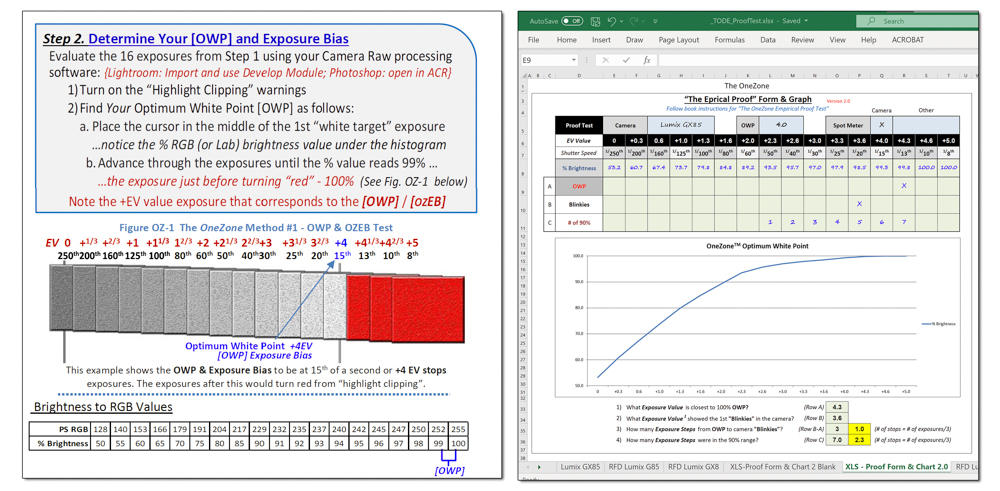
Applying Method #1
With your spot meter, meter the brightest part of the scene and then apply your exposure bias that will place the brightest part of the scene at 99% brightness in the processing software [the OWP].
The image below was shot in a boatyard on an overcast winter day. The boats were covered with white plastic. I spot-metered the brightest part of the plastic covering and then applied my exposure bias to the digital capture. This placed the brightest part of the scene at 99.7% brightness in the software OWP.

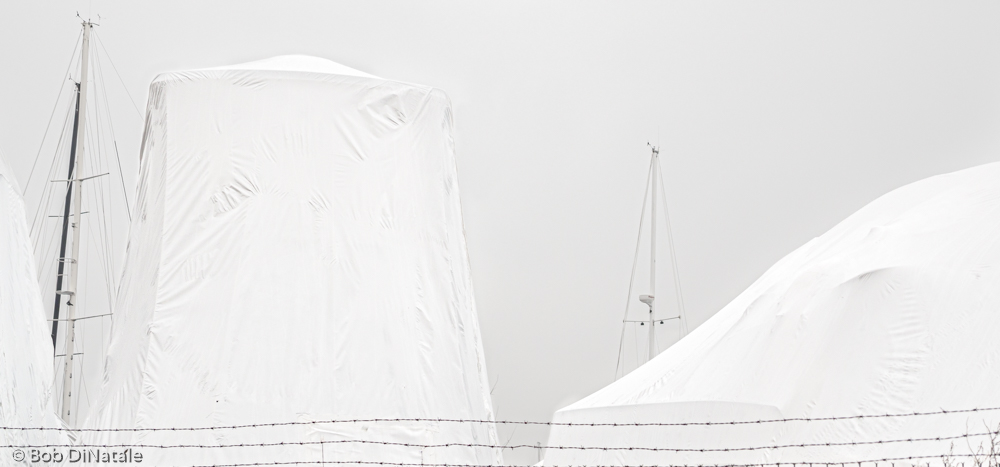
Method #2 – Using in-camera Multi-Zone Metering
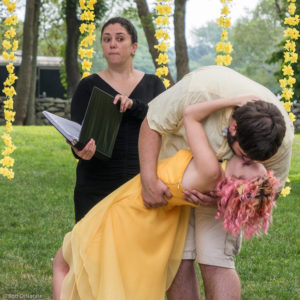 Is The Spot-Meter OneZone Method #1 Practical? Absolutely! It is perfect for scenes, in the studio – static subjects and photographic situations with ample shooting time.
Is The Spot-Meter OneZone Method #1 Practical? Absolutely! It is perfect for scenes, in the studio – static subjects and photographic situations with ample shooting time.
But what about photographing, cats, rabbits, grandkids, events; street scenes – situations with little setup time or subject matter that moves too fast for spot metering.
This is where the OneZone Method #2 is more practical. It may not be as precise as Method #1 but it provides the digital photographer with a real-world option for optimizing their digital exposures.
OneZone Method #2 consists of taking a set of 3 bracketed exposures. The base exposure will be EV +1.3 stops more than the camera meter’s recommended exposure. The next two bracketed exposures will be exposed at -2/3 and +2/3 stops from the base exposure. The results will be a set of 3 exposures ranging from +2/3 to +2-stops more exposure than recommended by the camera’s meter. [In the book I describe how to work with these OZ Bracket Sets.]
“One Zone Bracket Set” 1st Exposure = +1.3 EV
3 exposures: 2nd Exposure = +0.6 EV
* Note: I call it these methods “OneZoneTM because unlike the Zone System that needs consideration for both exposure and development at time of capture, with digital capture – there is only “OneZone” that matters for achieving optimum exposure – the Optimum White Point [OWP]. All other tones in the scene will be “darker” and fall on the camera’s sensor depending on the dynamic range of the scene. The “final placement” of these tones will be decided in the processing software to achieve the “Artist’s Vision”.
Choosing The Optimum Exposure in Method #2
In the “OZ Bracket Set”, the “most-optimum” exposure of the set cannot be determined in your camera. The evaluation must be done after importing your files to your raw processing software. The “most-optimum” exposure of the set is determined by turning on the software “Highlight Clipping”.
In the example of the ice-coated roofs below, the exposure that shows no red clipping in highlight detail areas is the 2nd exposure. However the “most-optimum” exposure of the set is the 1st exposure EV+1.3.

WHY? There can be some red highlight warning in a “most-optimum” exposure, especially if the photo includes sunlit bright snow, specular highlights, etc. In the example above you might choose the middle +0.6 EV exposure, however, the red “Highlight Clipping” on the roof in the first exposure, +1.3 EV, could also be used. The bright snow-covered roofs in bright sunlight would look natural being 100% – white with no texture. Remember, the expression of the Artist’s Vision is what matters.
Why Bracket?
The “most-optimum” exposure of the set could be the first, second or third. This could vary with the framing of your scene in the viewfinder, “exposure subject failure”, the camera’s “Multizone” metering, the dynamic range of the scene, etc.
The two examples below will illustrate the effect of “brightness subject failure”. When determining which bracket:
- a brighter scene (white sweater) will force a darker exposure. (Notice the brackets below have no highlight clipping even at the +2EV exposure. In this case I would use the 3rd exposure… +2EV.)
White Sweater OneZone Bracket Set
1st Exp. = +1.3 EV 2nd Exp. = +0.6 EV 3rd Exp. = +2.0 EV


• a dark scene (black sweater) will force a lighter exposure. (Notice the brackets below have “Highlight Clipping” even at the darkest bracketed exposure +0.6 EV. In this case, I would use the 2nd exposure +0.6 EV.)

1st Exp. = +1.3 EV 2nd Exp. = +0.6 EV 3rd Exp. = +2.0 EV
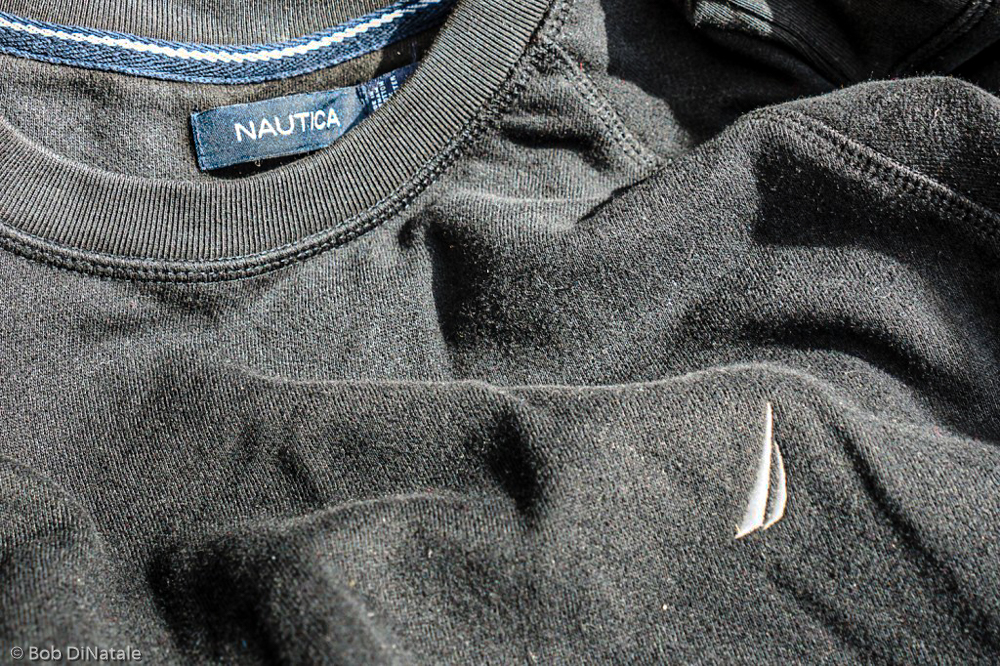
The Wrap
“We know that the ‘Final’ exposure does not happen in our camera but in our software.”
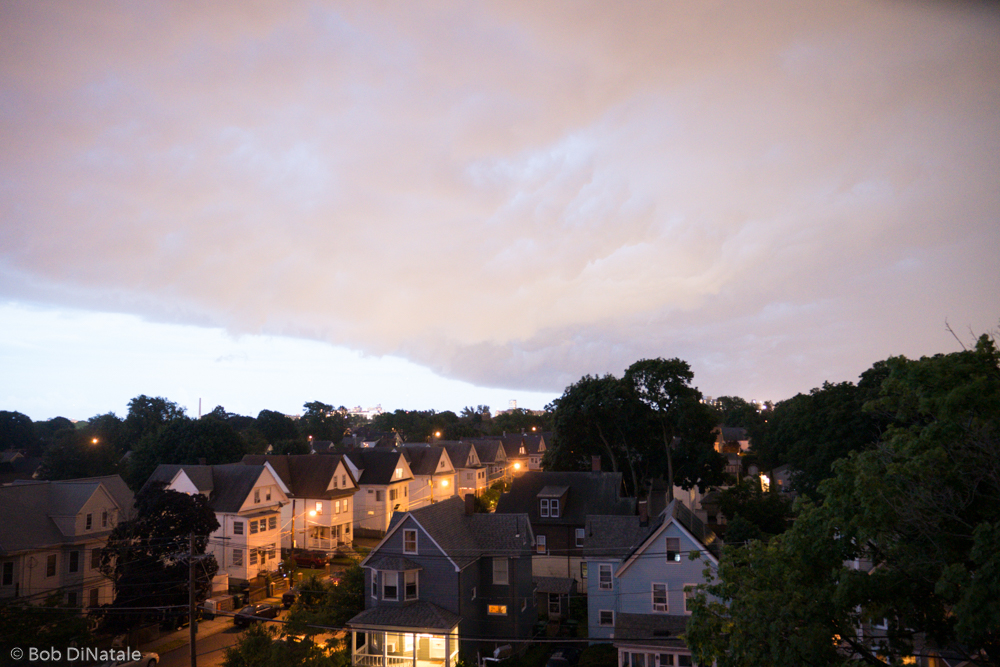
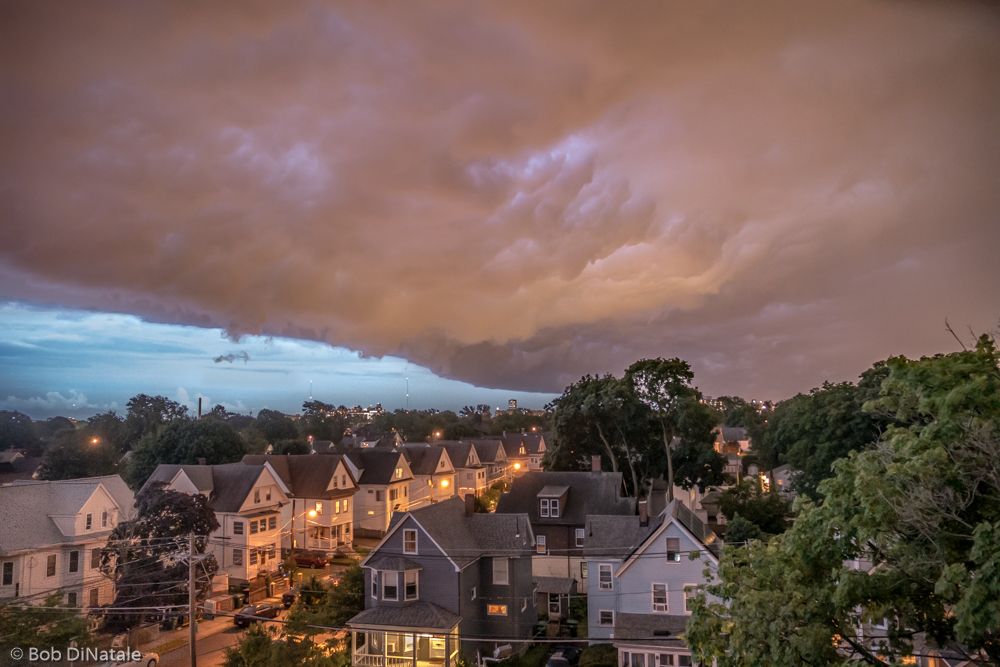
“We know how important The Optimum Digital Exposure is to our ‘final processed’ image”

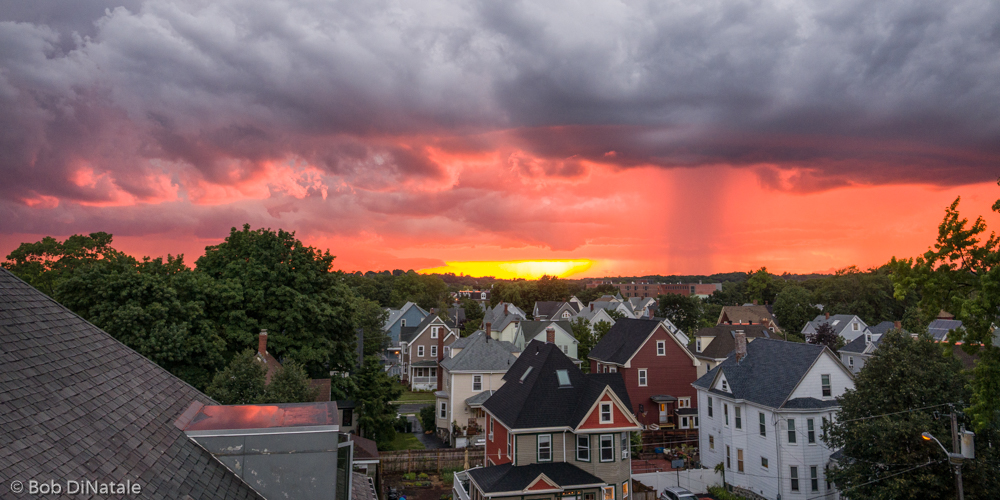
“We know Exposure Compensation happens in two places:
…in the camera: more exposure compensation – ETTR
…in the software: less exposure compensation – ETTL
Observation “Digital Capture needs ETTR… Digital Processing needs ETTL”
In your digital software, when using the “Exposure” slider to balance for a general exposure:
- if the “Exposure” slider has a minus value – it is a good indication that you have optimized your digital capture.
- if the “Exposure” slider has a plus value – it is a good indication that you have underexposed your digital capture – and lost valuable scene data



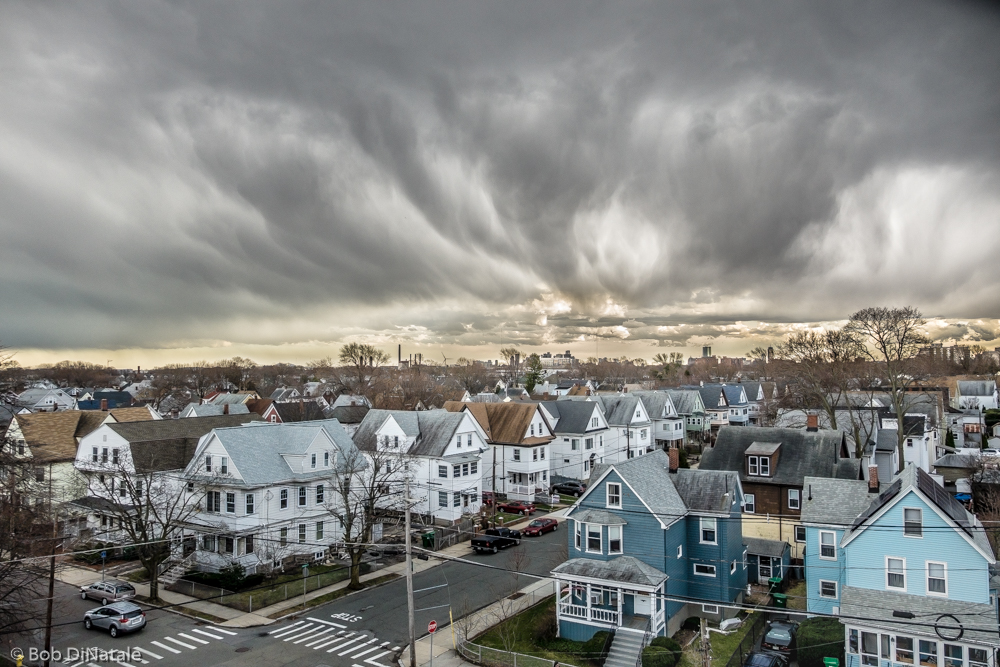


And In The End (The Light You Take Is Equal To The Light You Make)
Another, not-so-apparent benefit of The Optimum Digital Exposure, is that since first introduced there have been many advancements in Camera Raw processing software. Digital processing technology will continuum to improve. If we optimize our digital capture today, there is no telling what detail we will be able to extract from that same Optimum Digital Exposure years from now!
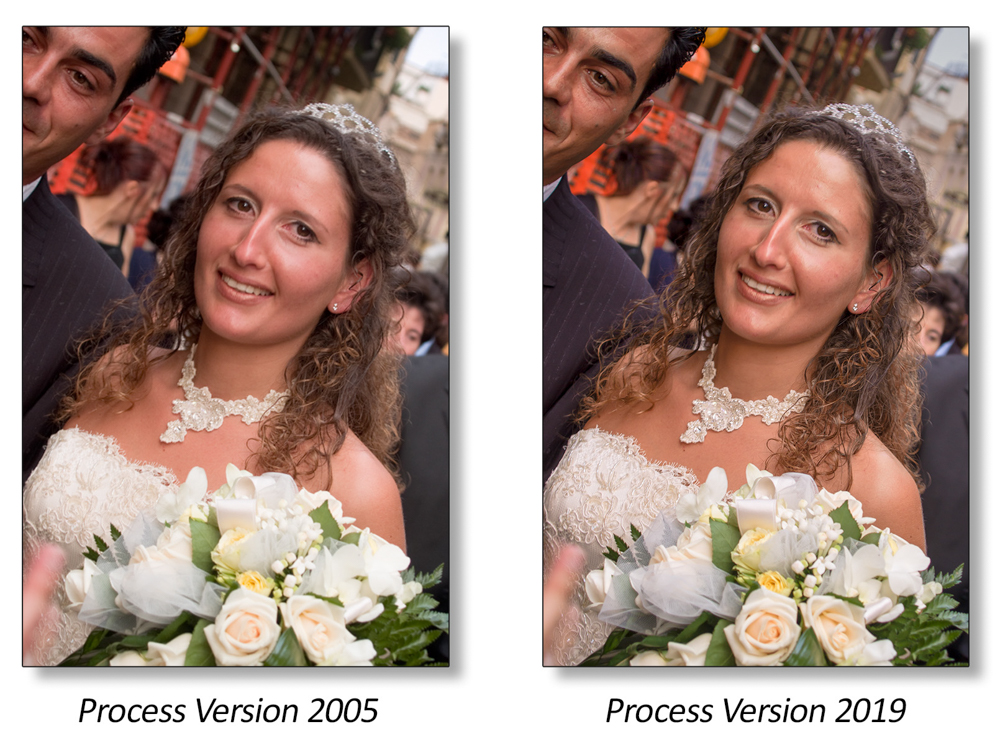
“The Camera RAW capture is the perpetual latent image!”
About the Author
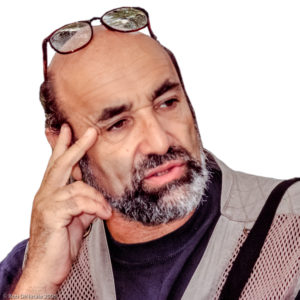 Bob DiNatale is an Adobe Certified Photoshop Lightroom Expert and an X-rite Coloratti.
Bob DiNatale is an Adobe Certified Photoshop Lightroom Expert and an X-rite Coloratti.
He has a US Patent in Color Printing; worked with experimental silver emulsions at Polaroid; taught both the Nikon and Time Life Schools of Photography and founded the Olympus School of Digital Photography.
Bob conducts a free online Forum where he analyzes your photos from capture to processing with consideration for your artistic intent. For more info and to sign up for his free Forum check out his Forum page: www.bobdinatale.com/forum/
The Optimum Digital Exposure – Introducing the OneZoneTM Method of Digital Exposure
You can purchase Bob’s book at the PhotoPXL store for $20.00 USD as a PDF download
For more details and examples go to www.OneZone.photos
Bob can be contacted by email at [email protected] or from his website www.BobDiNatale.com
Bob DeNatale
November 2020
Medford, Massachusetts
Author, teacher and inventor, Bob currently conducts workshops, lectures and private instruction in the area of digital photography. [Adobe Photoshop Lightroom Certified / Xrite Coloratti ] 50 years of photographic involvement that includes: > FILM: worked at Polaroid R&D in silver emulsions and optical sensitizing dyes; a US patent in color printing; > DIGITAL: first presented digital media productions in 1984; founded the Olympus School of Digital Photography in 1998. > INSTRUCTION: Nikon School of Photography; Time-Life School of Photography; Boston University; University of Massachusetts. > AUTHOR: "The Optimum Digital Exposure"; "Processing the Digital Image"






